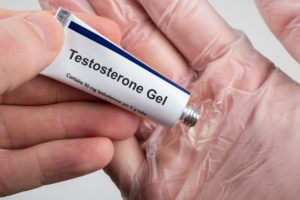The simplified DUTCH Report has arrived, and current DUTCH Providers are eligible for up to 5 DUTCH Complete or DUTCH Plus test kits for 50% off. Learn more and claim this offer!
Monitoring Patients on Transdermal Testosterone Replacement
Mark Newman, MS
Monitoring patients on transdermal testosterone replacement
by Mark Newman, MS
Testosterone Replacement Therapy (TRT) using testosterone gel.

In our previous blog, “Yes! Urine Testing Can Be Used to Monitor Transdermal Estrogen Creams or Gels” , we concluded that transdermal estradiol is effectively monitored with DUTCH testing, whereas transdermal progesterone is not. So what about testosterone?
When testosterone is taken by cream or gel, it behaves more similarly to estradiol rather than progesterone. Here is what we know:
- Doses of 25-100mg of transdermal testosterone modestly increases testosterone values in urine and serum.
- Doses of 25-100mg of transdermal testosterone modestly lowers luteinizing hormone (LH) values. The brain gets similar exposure to testosterone as reflected in serum and urine testing.
- In men receiving 25-100mg of transdermal testosterone, only those with increased levels of testosterone, in serum (and presumably urine), show an increase in lean body mass (LBM). Conversely, in saliva, men without an increase in LBM, are still likely to show dramatically increased testosterone values. 1
- Doses of 25-100mg of transdermal testosterone increase salivary values exponentially. These values have not been shown to parallel any clinical responses to therapy.
The DUTCH Test has one additional piece of information to help interpret testosterone therapy. We also measure epi-testosterone. Think of epi-testosterone as a non-androgenic cousin of testosterone. It is typically made by the testis in about the same concentration as testosterone. This allows us to see approximately how much endogenous, testicular production is being produced when a man is taking testosterone therapy. A young, healthy man will have an epi-testosterone level of about 40-115ng/mg. (That’s the same range as testosterone.) A man who has completely shut down his natural testosterone production, will have an epi-testosterone value below 10ng/mg. As an example, over 90% of men taking regular injections (or having a recent pellet insertion) of testosterone show these suppression levels of epi-testosterone (<10).
What about men on transdermal testosterone? If the dose is too high, we’ll see epi-testosterone levels shut down, as the brain stops making LH and the testicles stop making androgens. The average man taking 25, 50, or 100mg of transdermal testosterone does not show these very low levels of epi-testosterone. When men take more than 100mg, levels of epi-testosterone parallel injections and pellets, and testicular production is shut down. Remember, a 25mg dose raises salivary levels of testosterone far higher than a typical injection.
The brain’s production of LH and the testicles’ production of epi-testosterone agree that doses of 25-100mg of transdermal testosterone are not the massive doses that high salivary results imply. All this data converges similarly as it does for estrogen. Serum and urine tell similar stories and agree with the clinical data available (LH and epi-testosterone suppression and increased LBM). Monitoring transdermal testosterone with the DUTCH Test is effective. As with estrogens, the results do not represent the high levels of testosterone present in the saliva gland, and this should be considered.
Testosterone replacement therapy can be a complex subject. While the above data supports the use of the DUTCH Test to monitor testosterone therapy by cream, gel, injection or pellet, we do not endorse any treatment protocol or dose.
References:
- Fred Sattler, Shalender Bhasin, Jiaxiu He, Chih-Ping Chou, Carmen Castaneda-Sceppa, Kevin Yarasheski, Ellen Binder, E. Todd Schroeder, Miwa Kawakubo, Anqi Zhang, Ronenn Roubenoff, and Stanley Azen. Testosterone Threshold Levels and Lean Tissue Mass Targets Needed to Enhance Skeletal Muscle Strength and Function: The HORMA Trial. J Gerontol A Biol Sci Med Sci. 2011 January;66A(1):122–129
TAGS
Hormone Replacement Therapy (HRT)
Androgens (Testosterone/DHEA)
Men's Health
Menopause